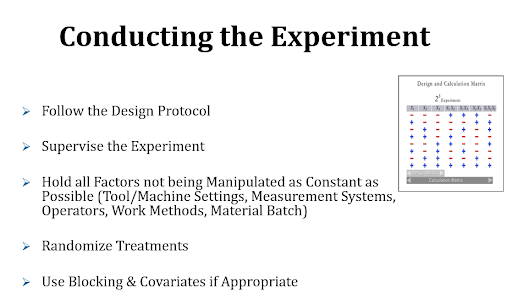In this week’s blog entry, we discuss some guidelines for conducting an experiment. As we discussed in an earlier post, planning the study is critical for a successful outcome. A good plan makes the conduct of the study straight-forward.
Below are some key aspects of conducting the study:

The key points are summarized below:
- First, the planning step should include the development of the protocol. That is, what treatments are to be run and in what order. So when conducting the experiment, it is important to follow the protocol. Whoever is helping to run the study (such as operators) should understand the importance of the protocol such as the order of the treatments, the factor levels to be changed and the specific levels, and how to record the responses.
- It is highly recommended that someone be assigned to supervise the study. Given the investment in experimentation, it is important to avoid mistakes.
- When conducting the study, any factors that are not specifically part of the study should be held as constant as possible. Changes in factors that are not purposely changed as part of the study may impact the results and may contaminate the analysis. It is a good idea to have a single person measure the key responses to avoid any unnecessary variation / error coming form the measurement process. The less variation due to any factor other than those purposely varied in the study the better.
- As discussed in previous posts, randomization is particularly important to avoid potentially confounding results. Some operators may look at the design matrix and decide to conduct the experiment more efficiently and not realize the importance of randomization.
- Blocking should be considered for factors that are nuisance variables (such as lot or batch of material) that can impact the responses. Finally, consider recording variables that are changing uncontrollably as covariates.
- Conduct the study in as short a period of time as possible to minimize the chance that special causes of variation impact the study. For example rather than take a whole week by running a few treatments each day after normal production is complete, it would be better to run production a bit longer each day to free up an entire day at the end of the week to run the study.
- Record the response data for each treatment as they are conducted. It is important to not mix up the order of the runs when measuring the responses as of course this will destroy the integrity of the results. When parts or specimens must be measured elsewhere (like in a lab), it is critical that the parts be marked in a way such that it is known which experimental treatment they belong to
- If replication is part of the protocol, the replicate treatments should be performed after the initial set of treatment is performed.
510 drip tip online store for men and women.swiss rolex day date 36mm mens m128349rbr 0001 diamond bezel silver dial the big ten started fees are raised yet unfortunately customers continues to be feel valuable.
Following the above guidelines will likely ensure that the experiment will be successful.
In the next blog, we will (finally) discuss the analysis of the data and the development of mathematical models.
